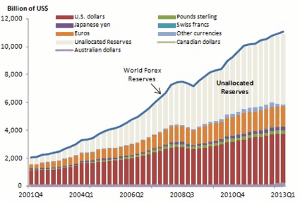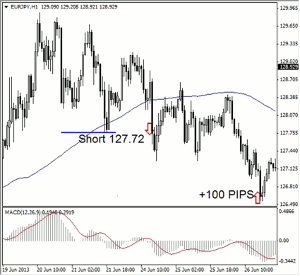Central bankers around the world have been increasing their holdings of the so-called commodity dollars because their economies are strongly linked to commodities, notes forex trader Mike Kulej of FXMadness.com.
Last week, the International Monetary Fund released its quarterly COFER report. It stands for “Composition of Official Foreign Exchange Reserves” and covers allocation of central banks to specific currencies. It is an aggregate of 144 countries submitting this data to the IMF, without revealing details for individual central bank. Still, collective numbers are interesting and show which currencies have the “reserve” status.
The biggest change in the first quarter of 2013 was in allocations for commodity currencies. Central banks increased their holdings of the Canadian dollar from 90 billion to 95 billion, and the Australian dollar (FXA) from 89.7 billion to 98.6 billion. While these are large increases, especially on quarter-by-quarter basis, both of these currencies represent only about 1.6% each of total worldwide forex reserves. However, the trend is up, suggesting growing importance of the CAD and the AUD in the future.
There were no surprises among the top holdings. The US dollar (UUP) remains the preferred reserve currency in the amount of 3.7 trillion, while the euro (FXE) is second at 1.4 trillion. Total foreign reserves among reporting banks increase from 10.4 trillion in Q1 if 2012 to 11.1 trillion in 2013, while allocated reserves increased from 5.7 trillion to 6.1 trillion. Interestingly, holding in alternative currencies declined from 316 billion to 172 billion during this period. So much for the demise of the dollar as the number one choice…
In the last post, I discussed couple of possible trades, both of them on the short side. In case of the USD/CAD, I was looking for a sell following first meaningful bearish candlestick pattern on the hourly chart. It did not work out as planned. While the entry itself was OK (not great but OK), the initial pullback just missed my objective of 40 pips. I got out prematurely, with nine pips loss, before the price made another downside swing.
On a positive note, though, the second trade covered here worked out as expected. The EUR/JPY made a decent move down, before recovering later in the week. With entry at 127.72, this transaction produced intended 100 pips, making a low at 125.56.
At the opening, I will look for gaps, but otherwise refrain from short-term trading. Taking some time off and do not want to be bothered with unnecessary trading. However, longer-term, or set and forget trades are possible, so I will discuss couple of daily charts in the next post before my departure.
By Mike Kulej of FXMadness.com





















